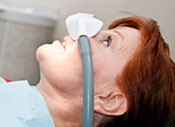Sedation Dentistry

Why Choose Sedation Dentistry?
For mild cases of anxiety related to dental care, Dr. Neilson offers nitrous oxide, which you inhale through a mask. This form of sedation dentistry enables you to drive home after the procedure. For more severe cases of anxiety, a mild oral sedative can be used.
These do not make you fall asleep but may give you a complete sense of relaxation during your visit with Dr. Neilson.
Conscious Sedation With Pills
IV Sedation
Nitrous Oxide (Laughing Gas)
Types of Sedation
Oral Conscious Sedation
Through the use of sedatives and pain relievers, oral conscious sedation produces a relaxed state of consciousness to lessen pain and discomfort. Patients who receive oral conscious sedation are still able to speak and respond to questions during treatment, and express any pain or discomfort they may be having, although they may remember very little or nothing about the procedure. Other side effects include headache, nausea and vomiting.
Nitrous Oxide Sedation
Nitrous oxide, more commonly known as “laughing gas,” is often used as a conscious sedative during a dental visit. The gas is administered with a mixture of oxygen and has a calming effect that helps phobic or anxious patients relax during their dental treatment. After treatment, the nitrous is turned off and oxygen is administered for 5-10 minutes to help flush any remaining gas. The effects wear off almost immediately. Nitrous oxide rarely has side effects, although some patients may experience minor nausea and constipation.
IV Sedation
Intravenous (“IV”) sedation is sometimes known as “sleep dentistry” or “twilight dentistry,” and involves administering a dose of sedatives directly into the bloodstream via an IV. IV sedation is highly effective for patients who are fearful or anxious about their dental visits, as the sedatives will calm the patient almost immediately. It also acts as an amnesiac, causing them to not remember the dental operation afterwards, even though the patient will remain conscious and responsive during the procedure.
General Anesthesia
General anesthesia puts a patient completely to sleep during a dental procedure. The anesthesia can be administered in a variety of ways, including injection, gas inhalation or through an IV, depending on the circumstances. Aside from keeping the patient unconscious, the sedation also acts as an amnesiac, causing the patient to forget the events immediately before and after the procedure. General anesthesia is very safe under trained supervision.
 Some people fail to receive the benefits of modern dental treatment because of a simple yet seemingly overwhelming problem: Fear. It isn’t uncommon to have a little anxiety about an upcoming dental procedure. But if your fears have kept you away from the dental office when you know you really should go — take heart! Using conscious sedation with nitrous oxide, we can help you lose that anxiety, and make the whole experience so stress-free that you may not even remember it when it’s over.
Some people fail to receive the benefits of modern dental treatment because of a simple yet seemingly overwhelming problem: Fear. It isn’t uncommon to have a little anxiety about an upcoming dental procedure. But if your fears have kept you away from the dental office when you know you really should go — take heart! Using conscious sedation with nitrous oxide, we can help you lose that anxiety, and make the whole experience so stress-free that you may not even remember it when it’s over.Nitrous oxide, a colorless gas with a slightly sweet odor, has been used in medicine for about a century; however its outdated nickname, “laughing gas,” is undeserved. It’s a safe and effective method of administering conscious sedation — which means that you’ll stay awake during the procedure. But when nitrous oxide is used in combination with a local anesthetic, you won’t feel pain or anxiety. In fact, many patients report a feeling of well-being during this type of sedation. All bodily functions remain normal during the administration of nitrous oxide, and its effects wear off quickly afterwards.
How Is Nitrous Oxide Administered?
 As a form of conscious sedation, nitrous oxide is inhaled through a small mask that fits comfortably over your nose. The gas is mixed with oxygen as it is being delivered, and both gases are always kept at a level that is safe for the body. In just a few minutes, you may start to experience a floating sensation, and perhaps some tingling in the hands and feet. That’s a sign that the sedation is working. Once it has been verified that you’re calm and comfortable, and that the dose is correct, your dental procedure can begin.
As a form of conscious sedation, nitrous oxide is inhaled through a small mask that fits comfortably over your nose. The gas is mixed with oxygen as it is being delivered, and both gases are always kept at a level that is safe for the body. In just a few minutes, you may start to experience a floating sensation, and perhaps some tingling in the hands and feet. That’s a sign that the sedation is working. Once it has been verified that you’re calm and comfortable, and that the dose is correct, your dental procedure can begin.Nitrous oxide itself isn’t a substitute for a local anesthetic — it’s considered an anxiolytic, which means it makes anxiety disappear. For some procedures, you may still need an anesthetic injection. The difference is, you won’t mind. Yet, you won’t be asleep — you’ll be able to speak, aware of what’s going on, and you will remain in control during the procedure. In fact, the dose can be fine-tuned to just the level of sedation you need.
When the procedure is over, the flow of nitrous oxide is decreased to zero, and the oxygen may be increased. After resting in the chair for a few minutes, you’ll be able to sit up, and soon you can resume normal activities like driving. Although the experience has been compared to “having a couple of drinks,” there is very little “hangover” effect afterward.
Who Can Benefit From Nitrous Oxide?
Most people whose anxiety would otherwise keep them out of the dental chair can benefit from conscious sedation with nitrous oxide. Before beginning treatment, we will take a complete medical history, including your use of both prescription and non-prescription medications. If you are pregnant, have COPD (Chronic Obstructive Pulmonary Disease) or some other pulmonary diseases, or are taking certain drugs, it may not be right for you. However, if you feel that you would benefit from a more stress-free experience in the dental office, talk to us about nitrous oxide conscious sedation.
